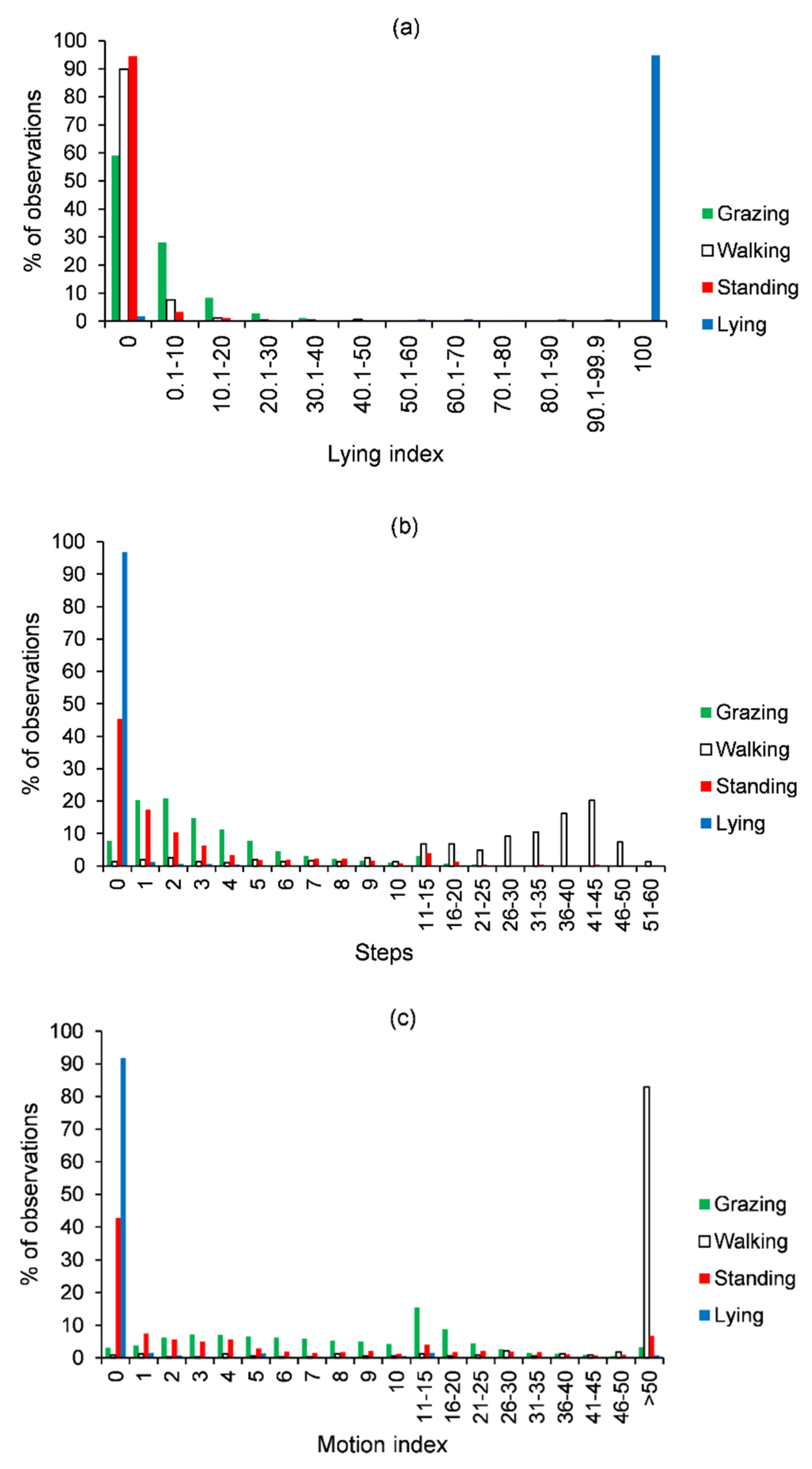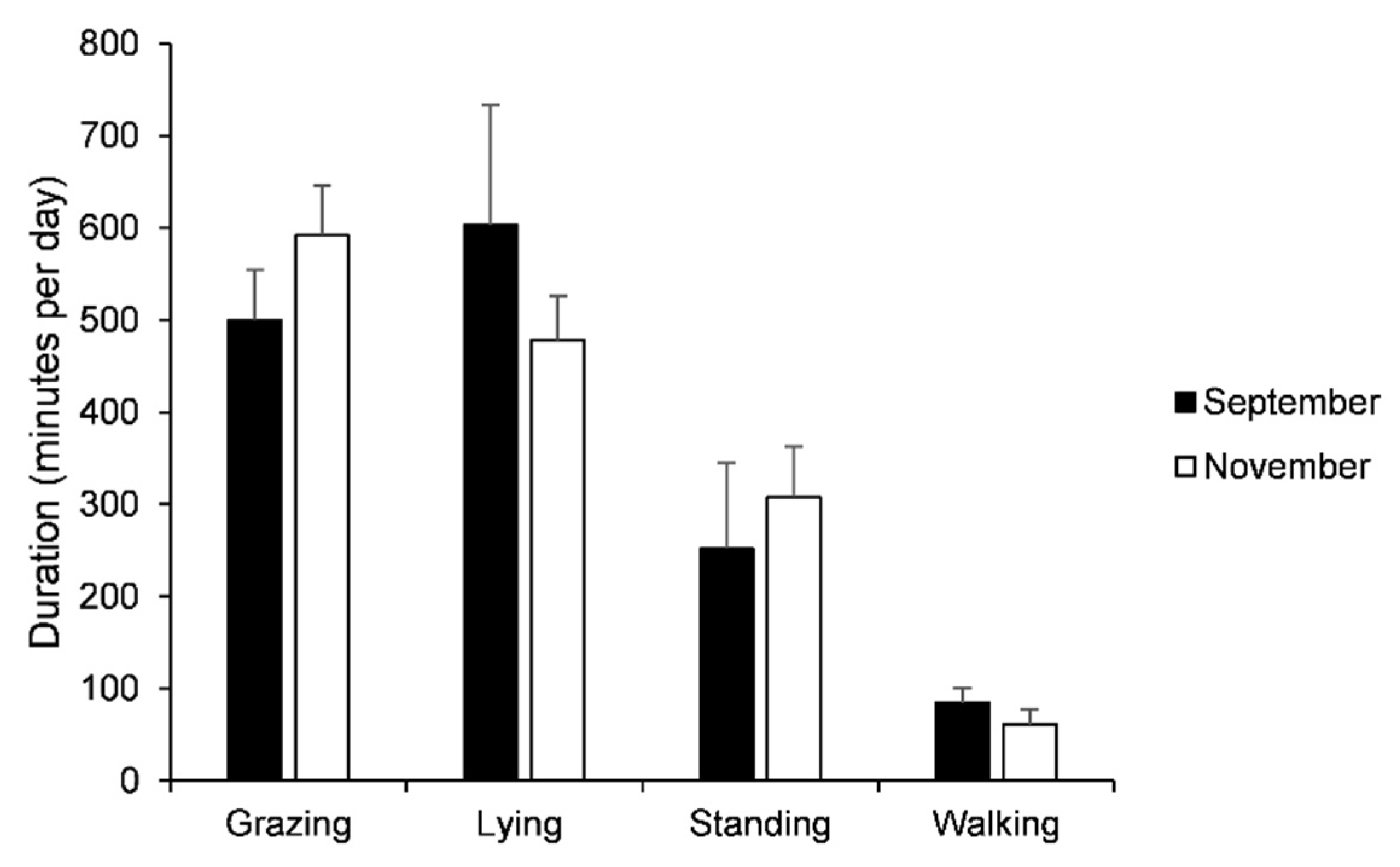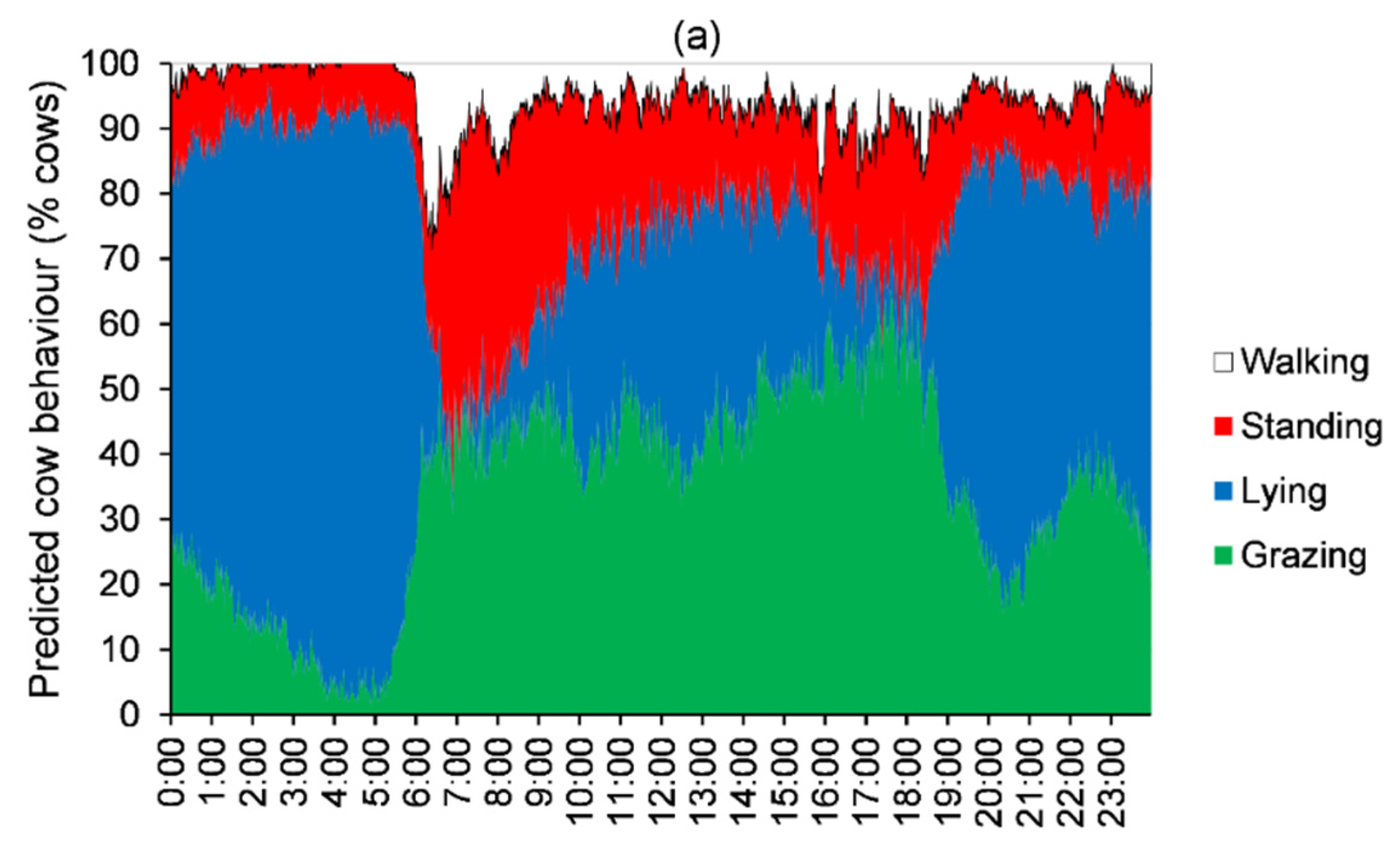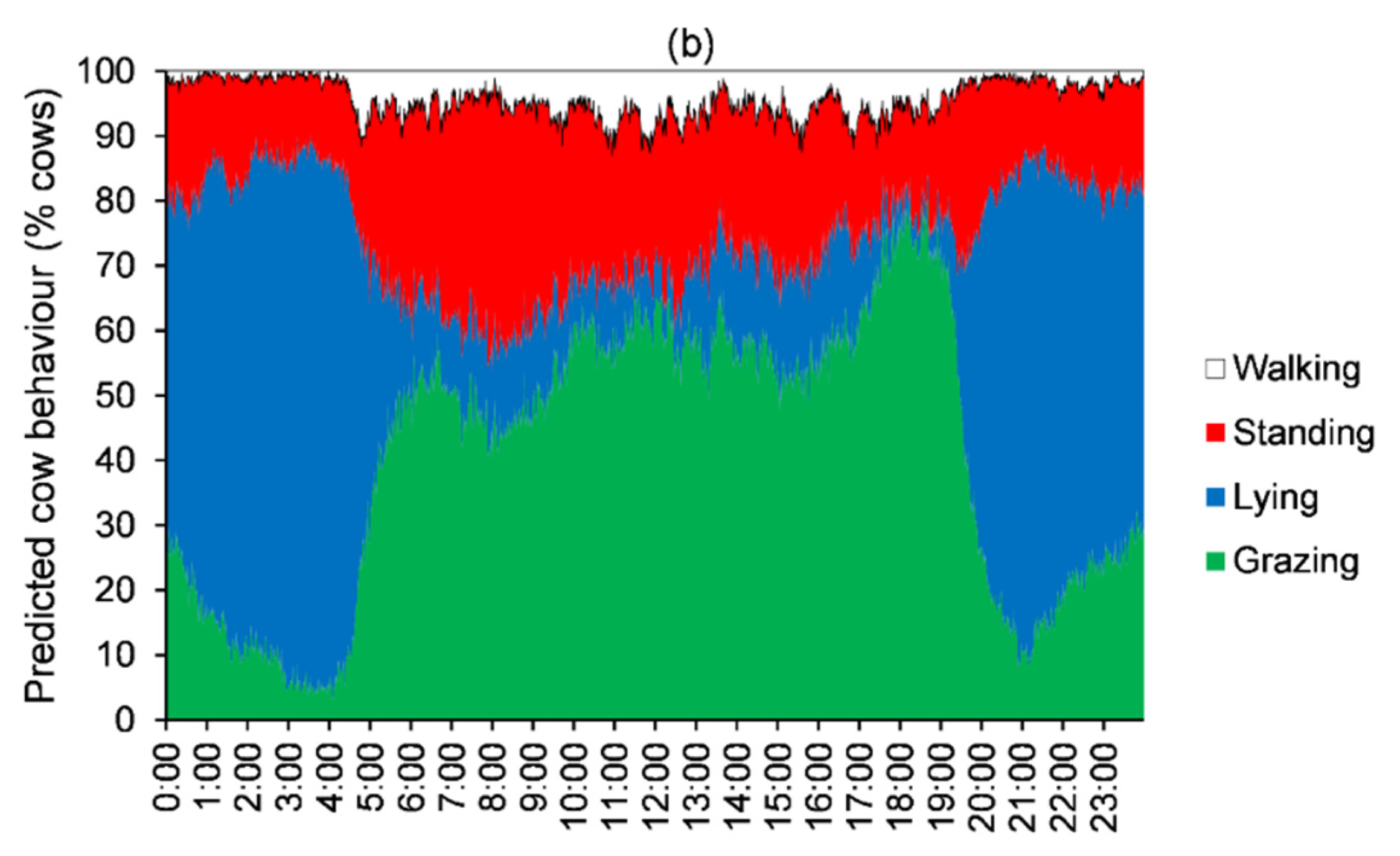Development of Thresholds to Predict Grazing Behaviour of Dairy Cows from Motion Sensor Data and Application in a Pasture-Based Automatic Milking System
Abstract
:1. Introduction
2. Materials and Methods
2.1. Site and Farm Details
2.2. Cow Selection and Behaviour Observations
2.3. Data Analysis
3. Results
3.1. Thresholds to Predict Behaviour
3.2. Predicted Dairy Cow Behaviour
3.3. Correlations between Behaviour and Cow Characteristics
4. Discussion
4.1. Thresholds to Predict Behaviour
4.2. Predicted Dairy Cow Activity
4.3. Correlations between Behaviour and Cow Characteristics
5. Conclusions
Author Contributions
Funding
Institutional Review Board Statement
Data Availability Statement
Acknowledgments
Conflicts of Interest
References
- Shalloo, L.; O’Donovan, M.; Leso, L.; Werner, J.; Ruelle, E.; Geoghegan, A.; Delaby, L.; O’Leary, N. Review: Grass-based dairy systems, data and precision technologies. Animal 2018, 12, s262–s271. [Google Scholar] [CrossRef] [PubMed] [Green Version]
- Clay, N.; Garnett, T.; Lorimer, J. Dairy intensification: Drivers, impacts and alternatives. Ambio 2019, 49, 35–48. [Google Scholar] [CrossRef] [PubMed] [Green Version]
- Beggs, D.; Jongman, E.; Hemsworth, P.; Fisher, A. The effects of herd size on the welfare of dairy cows in a pasture-based system using animal-and resource-based indicators. J. Dairy Sci. 2019, 102, 3406–3420. [Google Scholar] [CrossRef] [Green Version]
- Lyons, N.; Kerrisk, K.; Garcia, S. Milking frequency management in pasture-based automatic milking systems: A review. Livest. Sci. 2014, 159, 102–116. [Google Scholar] [CrossRef]
- Andriamandroso, A.; Bindelle, J.; Mercatoris, B.; Lebeau, F. A review on the use of sensors to monitor cattle jaw movements and behavior when grazing. Biotechnol. Agron. Société Environ. 2016, 20, 273–286. [Google Scholar] [CrossRef]
- Decruyenaere, V.; Buldgen, A.; Stilmant, D. Factors affecting intake by grazing ruminants and related quantification methods: A review. Biotechnol. Agron. Soc. Environ. 2009, 13, 559–573. [Google Scholar]
- McGowan, J.; Burke, C.; Jago, J. Validation of a technology for objectively measuring behaviour in dairy cows and its application for oestrous detection. In Proceedings of the New Zealand Society of Animal Production; NZSAP: Wanaka, New Zealand, 2007; Volume 67, pp. 136–142. [Google Scholar]
- MacKay, J.R.; Deag, J.M.; Haskell, M.J. Establishing the extent of behavioural reactions in dairy cattle to a leg mounted activity monitor. Appl. Anim. Behav. Sci. 2012, 139, 35–41. [Google Scholar] [CrossRef]
- Nielsen, L.R.; Pedersen, A.R.; Herskin, M.S.; Munksgaard, L. Quantifying walking and standing behaviour of dairy cows using a moving average based on output from an accelerometer. Appl. Anim. Behav. Sci. 2010, 127, 12–19. [Google Scholar] [CrossRef]
- Trénel, P.; Jensen, M.B.; Decker, E.L.; Skjøth, F. Quantifying and characterizing behavior in dairy calves using the IceTag automatic recording device. J. Dairy Sci. 2009, 92, 3397–3401. [Google Scholar] [CrossRef] [Green Version]
- Högberg, N.; Höglund, J.; Carlsson, A.; Saint-Jeveint, M.; Lidfors, L. Validation of accelerometers to automatically record postures and number of steps in growing lambs. Appl. Anim. Behav. Sci. 2020, 229, 105014. [Google Scholar] [CrossRef]
- Kokin, E.; Praks, J.; Veermäe, I.; Poikalainen, V.; Vallas, M. IceTag3D™ accelerometric device in cattle lameness detection. Agron. Res. 2014, 12, 223–230. [Google Scholar]
- Ungar, E.; Nevo, Y.; Baram, H.; Arieli, A. Evaluation of the IceTag leg sensor and its derivative models to predict behaviour, using beef cattle on rangeland. J. Neurosci. Methods 2018, 300, 127–137. [Google Scholar] [CrossRef] [PubMed]
- Johansson, B.; Redbo, I.; Svennersten-Sjaunja, K. Effect of feeding before, during and after milking on dairy cow behaviour and the hormone cortisol. J. Anim. Sci. 1999, 68, 597–604. [Google Scholar] [CrossRef]
- Spörndly, E.; Wredle, E. Automatic milking and grazing—Effects of distance to pasture and level of supplements on milk yield and cow behavior. J. Dairy Sci. 2004, 87, 1702–1712. [Google Scholar] [CrossRef] [PubMed] [Green Version]
- Kismul, H.; Spörndly, E.; Höglind, M.; Næss, G.; Eriksson, T. Morning and evening pasture access—Comparing the effect of production pasture and exercise pasture on milk production and cow behaviour in an automatic milking system. Livest. Sci. 2018, 217, 44–54. [Google Scholar] [CrossRef]
- Legrand, A.; Von Keyserlingk, M.; Weary, D. Preference and usage of pasture versus free-stall housing by lactating dairy cattle. J. Dairy Sci. 2009, 92, 3651–3658. [Google Scholar] [CrossRef] [PubMed] [Green Version]
- Gibb, M.; Huckle, C.; Nuthall, R.; Rook, A. Effect of sward surface height on intake and grazing behaviour by lactating Holstein Friesian cows. Grass Forage Sci. 1997, 52, 309–321. [Google Scholar] [CrossRef]
- John, A.; Garcia, S.; Kerrisk, K.; Freeman, M.; Islam, M.; Clark, C. The diurnal intake and behavior of dairy cows when access to a feed of consistent nutritive value is restricted. J. Dairy Sci. 2017, 100, 9279–9284. [Google Scholar] [CrossRef] [Green Version]
- Taweel, H.; Tas, B.; Dijkstra, J.; Tamminga, S. Intake regulation and grazing behavior of dairy cows under continuous stocking. J. Dairy Sci. 2004, 87, 3417–3427. [Google Scholar] [CrossRef]
- Fadul-Pacheco, L.; Liou, M.; Reinemann, D.J.; Cabrera, V.E. A Preliminary Investigation of Social Network Analysis Applied to Dairy Cow Behavior in Automatic Milking System Environments. Animals 2021, 11, 1229. [Google Scholar] [CrossRef]
- Albright, J. Feeding behavior of dairy cattle. J. Dairy Sci. 1993, 76, 485–498. [Google Scholar] [CrossRef]
- Cullen, B.; Weng, H.-M.; Talukder, S.; Cheng, L. Cow milking order and its influence on milk production in a pasture-based automatic milking system. Anim. Prod. Sci. 2020, 61, 306–312. [Google Scholar] [CrossRef]
- Primary Industries Standing Committee. Nutrient Requirements of Domesticated Ruminants; CSIRO Publishing: Melbourne, Australia, 2007. [Google Scholar]
- Ungar, E.D.; Schoenbaum, I.; Henkin, Z.; Dolev, A.; Yehuda, Y.; Brosh, A. Inference of the activity timeline of cattle foraging on a Mediterranean woodland using GPS and pedometry. Sensors 2010, 11, 362–383. [Google Scholar] [CrossRef] [Green Version]
- Gregorini, P. Diurnal grazing pattern: Its physiological basis and strategic management. Anim. Prod. Sci. 2012, 52, 416–430. [Google Scholar] [CrossRef]
- Rook, A. Principles of foraging and grazing behaviour. In Grass: Its Production and Utilisation; Hopkins, A., Ed.; Blackwell Science: Boston, MA, USA, 2000; pp. 229–246. [Google Scholar]
- Orr, R.; Penning, P.; Harvey, A.; Champion, R. Diurnal patterns of intake rate by sheep grazing monocultures of ryegrass or white clover. Appl. Anim. Behav. Sci. 1997, 52, 65–77. [Google Scholar] [CrossRef]
- Krawczel, P.D.; Lee, A.R. Lying time and its importance to the dairy cow: Impact of stocking density and time budget stresses. Vet. Clin. Food Anim. Pract. 2019, 35, 47–60. [Google Scholar] [CrossRef]
- Olmos, G.; Boyle, L.; Hanlon, A.; Patton, J.; Murphy, J.J.; Mee, J.F. Hoof disorders, locomotion ability and lying times of cubicle-housed compared to pasture-based dairy cows. Livest. Sci. 2009, 125, 199–207. [Google Scholar] [CrossRef]
- Dias, K.; Garcia, S.; Islam, M.; Clark, C. Milk yield, milk composition, and the nutritive value of feed accessed varies with milking order for pasture-based dairy cattle. Animals 2019, 9, 60. [Google Scholar] [CrossRef] [PubMed] [Green Version]
- Clark, C.; Kaur, R.; Millapan, L.; Golder, H.; Thomson, P.; Horadagoda, A.; Islam, M.; Kerrisk, K.; Garcia, S. The effect of temperate or tropical pasture grazing state and grain-based concentrate allocation on dairy cattle production and behavior. J. Dairy Sci. 2018, 101, 5454–5465. [Google Scholar] [CrossRef] [PubMed] [Green Version]




| Behaviour | Definition |
|---|---|
| Grazing | Record as grazing when the cow is eating grass with jaw movement. Normally cow will be walking slowly, occasionally standing still for several seconds, sometimes moving a few steps to get to another spot. (Record as grazing if standing still for <30 s or walking < 10 m.) |
| Standing | All four feet stand on the ground, and cow is not grazing. (Record as standing when stationary for >30 s.) |
| Walking | Cow walking with more than one leg moving continuously without grazing behaviour performed. (Record as walking when moving over a distance > 10 m.) |
| Lying | The cow has folded the front legs underneath her body or is laterally lying down (without grazing). |
| Behaviour | Thresholds | Interval | Se (%) | Sp (%) | PPV (%) | NPV (%) |
|---|---|---|---|---|---|---|
| Lying index and steps only | ||||||
| Lying | Lying > 50 | 1 min | 99.3 | 99.6 | 95.5 | 99.9 |
| 2 min | 95.6 | 100.0 | 99.6 | 99.6 | ||
| 5 min | 83.4 | 98.0 | 80.2 | 98.4 | ||
| Grazing | Lying ≤ 50, Steps ≥ 2– ≤ 14 | 1 min | 90.2 | 59.5 | 91.3 | 56.4 |
| 2 min | 92.4 | 56.4 | 91.0 | 60.9 | ||
| 5 min | 91.9 | 43.8 | 89.6 | 50.8 | ||
| Walking | Lying ≤ 50, Steps > 14 | 1 min | 78.3 | 97.8 | 70.1 | 98.6 |
| 2 min | 75.0 | 97.6 | 66.7 | 98.4 | ||
| 5 min | 44.7 | 95.2 | 32.5 | 97.1 | ||
| Standing | Lying ≤ 50, Steps < 1 | 1 min | 45.3 | 92.7 | 44.3 | 92.9 |
| 2 min | 39.7 | 94.5 | 48.2 | 92.4 | ||
| 5 min | 30.5 | 95.9 | 48.0 | 91.7 | ||
| Lying index, steps, and motion index | ||||||
| Grazing | Lying ≤ 50, Steps ≥ 2– ≤ 16, and Motion index < 50, and Lying ≤ 50, Steps < 2, and Motion index ≥ 2 | 1 min | 92.0 | 60.3 | 91.6 | 61.6 |
| 2 min | 94.8 | 53.5 | 90.7 | 68.2 | ||
| 5 min | 94.4 | 36.5 | 88.7 | 55.4 | ||
| Walking | Lying ≤ 50, Steps ≥ 16 | 1 min | 74.9 | 98.5 | 77.0 | 98.4 |
| 2 min | 71.4 | 98.2 | 71.6 | 98.2 | ||
| 5 min | 38.9 | 96.0 | 33.3 | 96.8 | ||
| Standing | Lying ≤ 50, Steps < 2, and Motion index < 2 | 1 min | 47.6 | 93.7 | 50.5 | 93.5 |
| 2 min | 39.0 | 96.4 | 58.0 | 92.5 | ||
| 5 min | 25.3 | 97.7 | 58.3 | 91.3 | ||
| September | November | |
|---|---|---|
| Lactation number (parity) | 3.5 (1–7) | 3.2 (1–6) |
| Days in milk (day) | 261 (30–428) | 148 (102–244) |
| Milk solids (kg/day) | 2.0 (0.8–3.4) | 2.1 (1.5–3.2) |
| Milking frequency (time) | 1.9 (1.2–3.0) | 2.2 (1.0–3.6) |
| Liveweight (kg) | 648 (514–738) | 616 (500–731) |
| Milking order (percentile rank) | 51 (35–70) | 48 (20–85) |
| Grazing | Lying | Standing | Walking | Lactation Number | Days in Milk | Milk Solids | Milking Frequency | Liveweight | |
|---|---|---|---|---|---|---|---|---|---|
| Lying | S: −0.83 N: −0.49 | ||||||||
| Standing | S: 0.49 N: −0.70 | S: −0.88 N: −0.12 | |||||||
| Walking | S: 0.59 N: 0.85 | S: −0.49 N: −0.49 | S: 0.14 N: −0.70 | ||||||
| Lactation number | S: 0.13 N: 0.20 | S: −0.06 N: −0.75 | S: 0.01 N: 0.40 | S: −0.05 N: 0.17 | |||||
| Days in milk | S: −0.49 N: −0.52 | S: 0.66 N: 0.19 | S: −0.64 N: 0.50 | S: −0.22 N: −0.55 | S: −0.33 N: −0.08 | ||||
| Milk solids | S: 0.52 N: 0.61 | S: −0.62 N: −0.37 | S: 0.52 N: −0.45 | S: 0.39 N: 0.60 | S: 0.59 N: 0.33 | S: −0.80 N: −0.60 | |||
| Milking frequency | S: 0.51 N: 0.70 | S: −0.49 N: −0.24 | S: 0.27 N: −0.71 | S: 0.63 N: 0.77 | S: 0.36 N: 0.08 | S: −0.63 N: −0.50 | S: 0.85 N: 0.81 | ||
| Liveweight | S: −0.32 N: 0.06 | S: 0.45 N: −0.38 | S: −0.51 N: 0.21 | S: 0.12 N: 0.22 | S: 0.52 N: 0.72 | S: 0.38 N: 0.12 | S: 0.06 N: 0.51 | S: 0.17 N: 0.29 | |
| Milking order | S: 0.20 N: −0.68 | S: −0.14 N: 0.22 | S: 0.02 N:0.73 | S: 0.32 N: −0.87 | S: 0.14 N: −0.11 | S: 0.11 N: 0.54 | S: 0.06 N: −0.51 | S: 0.02 N: −0.71 | S: −0.01 N: −0.23 |
Disclaimer/Publisher’s Note: The statements, opinions and data contained in all publications are solely those of the individual author(s) and contributor(s) and not of MDPI and/or the editor(s). MDPI and/or the editor(s) disclaim responsibility for any injury to people or property resulting from any ideas, methods, instructions or products referred to in the content. |
© 2023 by the authors. Licensee MDPI, Basel, Switzerland. This article is an open access article distributed under the terms and conditions of the Creative Commons Attribution (CC BY) license (https://creativecommons.org/licenses/by/4.0/).
Share and Cite
Cullen, B.; Li, Z.; Talukder, S.; Cheng, L.; Jongman, E.C. Development of Thresholds to Predict Grazing Behaviour of Dairy Cows from Motion Sensor Data and Application in a Pasture-Based Automatic Milking System. Dairy 2023, 4, 124-136. https://doi.org/10.3390/dairy4010009
Cullen B, Li Z, Talukder S, Cheng L, Jongman EC. Development of Thresholds to Predict Grazing Behaviour of Dairy Cows from Motion Sensor Data and Application in a Pasture-Based Automatic Milking System. Dairy. 2023; 4(1):124-136. https://doi.org/10.3390/dairy4010009
Chicago/Turabian StyleCullen, Brendan, Zelin Li, Saranika Talukder, Long Cheng, and Ellen C. Jongman. 2023. "Development of Thresholds to Predict Grazing Behaviour of Dairy Cows from Motion Sensor Data and Application in a Pasture-Based Automatic Milking System" Dairy 4, no. 1: 124-136. https://doi.org/10.3390/dairy4010009
APA StyleCullen, B., Li, Z., Talukder, S., Cheng, L., & Jongman, E. C. (2023). Development of Thresholds to Predict Grazing Behaviour of Dairy Cows from Motion Sensor Data and Application in a Pasture-Based Automatic Milking System. Dairy, 4(1), 124-136. https://doi.org/10.3390/dairy4010009







